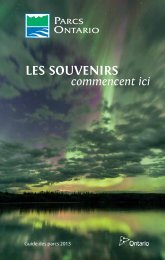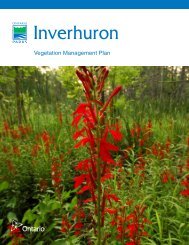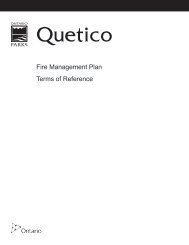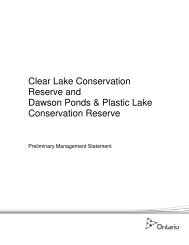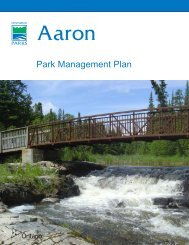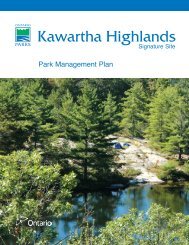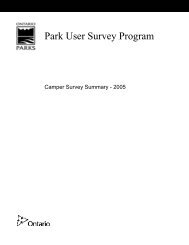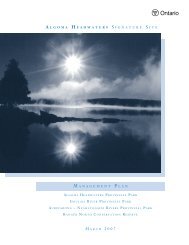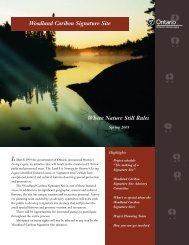Sandbanks Draft Veg Mgmt Plan - Ontario Parks
Sandbanks Draft Veg Mgmt Plan - Ontario Parks
Sandbanks Draft Veg Mgmt Plan - Ontario Parks
Create successful ePaper yourself
Turn your PDF publications into a flip-book with our unique Google optimized e-Paper software.
APPENDIX F – Woodlands Monitoring Protocol<br />
transect, and a photo is taken of the transect. The same transects will be evaluated<br />
each time. Orange paint should be brought each year to touch up the marks.<br />
10 m<br />
25 m<br />
75 m<br />
Photographic Monitoring<br />
One of the easiest methods of tracking vegetation change is to photograph an area in<br />
the same location over regular intervals. Although this has not been initiated yet, it can<br />
be initiated immediately in the forested area of the campground and repeated in 5 year<br />
intervals or sooner, depending on staff availability and the rate of vegetation change<br />
• Photos should be taken during downed woody debris monitoring (mid-May) and<br />
during vegetation monitoring (mid-June)<br />
• Photos should be taken with a digital camera. An attempt should be made to take<br />
the pictures in favourable light conditions, and at as high a resolution as possible.<br />
• Photos should be taken at the end of each 10 m transect, so that the transect, the<br />
base tree, and some of the surrounding area is visible. The individual ID information<br />
for the photo should be written on a board and visible within the photo. For example,<br />
the photo taken at campsite 626, at the 75 m distance, in May 2006 should say: 626<br />
– 75 May/06.<br />
• Exact locations of all photos taken should be recorded and stored with the photos<br />
(including campsite post number, direction photos taken in, and GPS coordinates if<br />
possible).<br />
• Photos should be stored on CD, but should also be printed and saved in hardcopy.<br />
<strong>Veg</strong>etation<br />
This protocol allows comparison of numbers, not percent cover, of native and non-native<br />
plants species and tree saplings and shrubs among distances from campsites and<br />
years. It is based on a protocol developed for monitoring tallgrass prairies. Number is<br />
preferable to cover as it is less subjective, faster to evaluate, and simplifies the analysis.<br />
• <strong>Veg</strong>etation monitoring should occur in mid June, prior to the end of the school year<br />
and the July long weekend. This will allow us to evaluate vegetation abundance<br />
without disturbing park visitors and before they can have an immediate impact on<br />
these variables.<br />
• The number of all herbaceous individuals less than 50 cm in height are counted within<br />
a 1 m wide area centred on the 10 m transect (ie: a 10 m 2 plot). In most cases this is<br />
quite easy as understorey diversity and abundance is low. In areas with high<br />
abundance of individual plants numbers can be estimated.<br />
• The number of tree saplings and shrubs (woody species greater than 50 cm in height<br />
and less than 5 cm diameter at breast height) are counted within the same transect as<br />
the herbaceous vegetation.<br />
Downed Woody Debris<br />
This protocol allows comparison of numbers, not volumes, of downed woody debris<br />
among distances from campsites and years. It is based on elements of the Ecological<br />
<strong>Sandbanks</strong> <strong>Veg</strong>etation Management <strong>Plan</strong> A-20<br />
<strong>Ontario</strong> <strong>Parks</strong>, SE Zone<br />
2009



